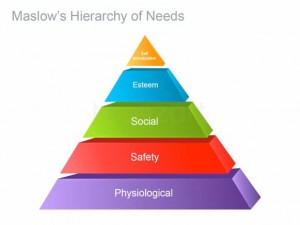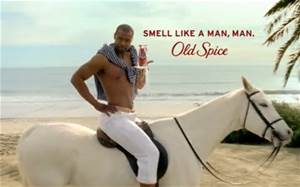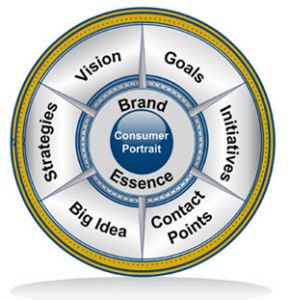“When you think of Nike you think of something different than a shoe company…in their advertising they honor great athletes and they honor great athletics. That’s who they are. That’s what they are about.”
– Steve Jobs – in his speech introducing Apple’s “Think Different” campaign.
What Jobs is describing is brands that have a “point-of view” – and those that have turned that point-of-view into a differentiating essence that has set them apart from competition and created an “Inspirational Brand” – brands that have become what Jobs describes as “…one of the greats of the greats, not just in this country but around the globe.”
And a point-of-view is a strategic choice.
Functional benefits are not enough.
Inspirational Brands, or the “greats of the great”, define their business beyond functional attributes to include the fundamental values they believe in. This becomes their operating philosophy, or more directly, their “point-of-view”.
A POV gives your brand direction and helps you make critical decisions from product pipeline, to package design, strategic relationships, sponsorships and corporate philanthropy. And importantly, it drives consumer communication and relationship building.
- Hallmark is not just in the greeting card business – it is a provider of inspiration and tools to help consumers build powerful human connections.
- Playskool is not merely a manufacturer of toys, but an agent in your child’s development.
- Apple is not a computer manufacturer, but an enabler helping those passionate people who (in Job’s words) “…are crazy enough to think they can change the world”. Hence, the “Think Different” campaign.
Finding your POV in basic human values.
Inspirational Brands embody values that are fundamental to the human condition and connects them to the brand in a relevant way. Consumers’ values and beliefs influence their purchase decisions and the more you can mirror their set of values and beliefs, the more they are likely to be persuaded and motivated by, and attracted and connected to, your brand.
“Ram Tough” is more than slogan; it’s a hard working man’s self confidence that says “I get the job done”.
“Army Strong” connects on the values of Idealism, Honor and Commitment.
Harley Davidson appeals to the non-conformist in you.
Starbucks connects on the desire for community.
If you’re in the hotel business, it’s not about price, it’s about creating memories. If you’re in the tire business it’s not about mileage, it’s about family safety. If you’re in the fragrance business it’s not about the smell, it’s about the attraction. If you’re in the car insurance business it’s not about rates it’s about peace of mind (ok, today, it’s about rates, but I smell an opportunity!).
Therefore, this decision – to connect to a basic human value – is a strategic one – it is a choice you make that tells the consumer who you are and what you stand for.
What does a POV do?
Beyond connecting to the hearts and minds of your potential constituency in an inspirational way, on a practical level, a POV also allows your consumer communication to remain strategically consistent at all touch points, creates campaign longevity and in the end, creates an enduring brand identity and essence.
It becomes what you are known for.
It’s an equity you own.
It differentiates your brand amongst competition especially if you’re in a commodity category.
It can drive business and create loyalty.
It can make you an Inspirational Brand – a great among greats.
A case-in-point: Old Spice “Smell like a Man, Man”
 “What a man can be, he must be. This need we may call self-actualization…It refers to the desire for self-fulfillment, namely, to the tendency for him to become actualized in what he is potentially…”
“What a man can be, he must be. This need we may call self-actualization…It refers to the desire for self-fulfillment, namely, to the tendency for him to become actualized in what he is potentially…”
– Abraham Maslow
In his quest to understand what motivates people, Abraham Maslow came to believe that people are motivated (inspired) to achieve certain needs, often depicted as hierarchical levels within a pyramid, with self-actualization being at the top.
When this author began to work on the revitalization of Old Spice – a brand often referred to as “my Grandpa’s brand” – we found that our target audience had realistic perceptions of themselves, others and the world around them – a trait of those “self-actualized”. That perception was that it’s OK to be a man and act like a man – to be masculine in all the right ways a man should be and not have to apologize for it.
“Grandpa’s brand” was indeed masculine, but in an “old-fashioned” sense – somewhat stiff, romanticized and perhaps even a bit chauvinistic. But it did make you smell good. So what? Our target could not relate to that definition of masculinity. They rejected it and therefore the brand, even though in blind tests, the fragrance often scored at or near the top vs. competition.
What to do? Create a new definition of masculinity for Old Spice.
So, working under a platform of “unapologetic masculinity”, Old Spice began to bring their image of manliness into the 21st century – an image that said, it’s OK to be a man – confident, even bold, with a sense of humor that can even be self-deprecating (in a confident way). He’s fun, loves life and women (in a respectful way) – and importantly, does not have to apologize for being all of that. He just wants to be what a man needs to be…”the guy other guys want to be and the guy the girls want to be with.”
And by the way, he wants to “smell like a man, man” – and his girlfriend want him to smell that way, too.
This is the brand’s point-of-view and it has propelled “Grandpa’s brand” from an also-ran, in what is essentially a commodity category, into the market leader in men’s deodorant with a share hovering around 25%.
This is an Inspirational Brand.
How do you find your POV?
Develop contextual understanding.
Grow eyes and ears that are open to what you normally don’t see – the deeper motives beyond the functional needs of your consumer. What’s driving what they do and feel, where they shop and what they shop for, why they like your competitor’s equally functional brand more than yours, how they feel about themselves? What motivates their attitudes? What inspires them? And what can you do to connect with consumer motivations at the deepest level?
Then add to that the context in which they find themselves – a faltering or a robust economy, shrinking job prospects or general consumer optimism, environmental concerns, current events, surging nationalism, current pop culture, or emerging trends. What are the current key influences in their lives that affect their basic values in a negative or positive way?
And how does your brand fit amongst all that?
This requires deep work – insights development, customer profiling, category understanding, competitive intelligence, strategic decision making and long term planning.
Do the work. Find the connection. Create a point-of view.
Become an Inspirational Brand.
We can help.
TPG’s Marketing & Innovation Practice uses a Brand Strategy Development process to answer three fundamental questions that define effective brand strategies and help you find a point-of-view – who are we targeting, what is required to win with this target, and how will we execute these strategies in the market?
Our consulting services include:
- Brand Diagnostics
- Consumer Portraits
- Brand Essence
- Brand Plans
- Identifying Big Ideas
- 360° Communication Plans
To discuss how we can help your brand inspire and develop a point-of-view, please contact us:

